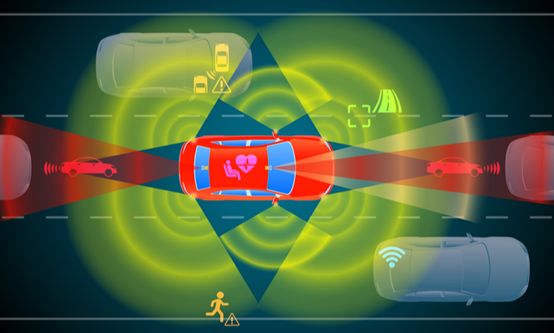目前,全球大多数车祸都是由驾驶员失误造成的向前碰撞事故。对此,汽车制造商正在奋力开发先进驾驶员辅助系统(ADAS)以防止撞车事故的发生,但目前的效果仍尚不尽如人意;第二篇则将探讨增加一个高性价比的定向激光雷达传感器将如何有助于防止正面碰撞事故的发生。
定义问题
根据美国公路交通安全局(NHTSA)提供的 2016 年全美车祸数据,至少50% 以上的车祸致死、致伤或财产损失事故均为多车连环事故,且其中至少有一辆车面向前方。[1] 2016 年,此类车祸已经造成超过 1.2万人死亡、1,20万人受伤,另造成超过 270万起财产损失。[2]具体来说,这些多车连环车祸包括追尾碰撞(占 2016年各类碰撞总量的 32.6%)和正面碰撞(占2.6%)。另外,还有 20.9% 是有一定角度的碰撞,且我们可以合理推论,在角度碰撞事故中,至少有一辆车经历了前向碰撞。
在2016年,全美 15.9% 的车祸均与撞上固定物体有关,如电线杆、路边石、沟渠、树木、栏杆、桥梁等,并最终导致 1万余人死亡、37万人受伤、77.8万起财产损失报告。对此,我们可以合理推断,绝大多数直接撞上固定物体并导致死亡或受伤的撞车事故都是正面碰撞。
此外,2016 年所有撞车事故中有 2.1% 涉及行人或自行车。此类事故的危险性极高,占所有车祸致死事故的 16.2%,死亡人数超过 6,500 人,且绝大多数均与乘用车的正向碰撞有关:87% 的行人和85% 骑自行车的人均死于这种情况。[3]75% 行人车祸致死事故发生在低光照条件下。[4] 2016 年,有 10% 的撞车事故是直接撞上其他停放车辆或动物。对此,我们有理由认为,此类碰撞事故也应呈现相同规律,即大多数伤害都涉及正面碰撞。因此,尽管这些事故中可能也包含侧面碰撞和追尾碰撞,但我们可以合理得出结论,2016 年与行人、自行车、动物和停放车辆的正面碰撞,约占所有撞车事故的 10%。
基于这些涉及动物、自行车、行人、固定物体和其他移动和停放车辆的碰撞事故数据,我们可以保守估计,2016 年,在全部 7,277,000 起车祸中,76% 均涉及正面碰撞。
性能优化的机遇与影响
我们可以从多个方面判断交通事故的总影响并权衡各种对策的优劣。根据 NHTSA 的统计结果,2010 年交通事故造成的总经济和社会影响损失达到惊人的 8,360 亿美元。[5]事实上,这一数字在中间几年还有所增加;2010 年至 2016 年间,交通事故死亡人数增长了 12%,受伤人数增长 29%[6]。因此,根据我们上文的估算,2016 年,全美正面碰撞事故造成的经济损失保守达6,350 亿美元。这些正面碰撞事故已经造成了至少 2.7w万人死亡、150 万人受伤。[7]
目前,市面上的正面碰撞预防系统已经在防止正面碰撞事故发生方面发挥了显著的作用。具体来说,美国公路安全保险协会(IIHS)报告称,按照出警记录,通用汽车配备了自动紧急制动(AEB)和正面碰撞警告系统的车辆,比不具备同类功能的相同车型发生追尾事故的概率降低了 43%。[8] 这一信息令人鼓舞,但仍有巨大改进空间。统计数据表明,即使所有道路车辆均安装了这种高级驾驶系统,2016 年的所有正面碰撞事故中有 57% 扔无法避免。事实上,真实的ADAS 性能指标很少公布;然而,如果我们将通用汽车 AEB 系统预防追尾事故的成功率应用至其他正面碰撞场景,则可以推断出,这些未解决的碰撞问题导致的社会损失大约为3,620 亿美元(占总量 6,350 亿美元的 57%)。
事实上,这对汽车安全公司而言意味着巨大的机会。本文提出,一个基于前向激光雷达传感器设计的 ADAS 系统可以防止目前系统 90% 无法应对事故。这种性能优化可以挽回 3,250 亿美元的社会损失(即总量3,620 亿美元的 90%),如果平摊至2016 年在美注册的 2.88 亿辆汽车,相当于每辆车可以至少避免1,100 美元的损失。在本文第二部分中将介绍到,使用激光雷达传感器为感知组件可以极大地提高 ADAS 系统的安全性能。
关于作者
-
Mircea Gradu 博士 Velodyne激光雷达公司 验证高级副总裁 及 首席质量官
-
David Heeren 博士 Velodyne激光雷达公司 高级技术产品市场经理
文献参考
[1]National Highway Traffic Safety Administration (NHTSA), “Crashes by FirstHarmful Event, Manner of Collision, and Crash Severity, 2016,”https://cdan.nhtsa.gov/SASStoredProcess/guest.
[2]These statistics are conservative because they reflect reported incidents,which may have involved multiple fatalities or injuries.
[3]NHTSA, “Traffic Safety Facts, 2016: Pedestrians,”https://crashstats.nhtsa.dot.gov/Api/Public/Publication/812493.
NHTSA,“Traffic Safety Facts, 2016: Bicyclists and Other Cyclists,”“https://crashstats.nhtsa.dot.gov/Api/Public/ViewPublication/812507.
[4]NHTSA, “Traffic Safety Facts, 2016: Pedestrians,”https://crashstats.nhtsa.dot.gov/Api/Public/Publication/812493.
[5]NHTSA, “The Economic and Societal Impact of Motor Vehicle Crashes, 2010”;https://crashstats.nhtsa.dot.gov/Api/Public/ViewPublication/812013.
[6]NHTSA, “Traffic Safety Facts 2016,”https://crashstats.nhtsa.dot.gov/Api/Public/ViewPublication/812554.
[7]NHTSA, “Crashes by First Harmful Event, Manner of Collision, and CrashSeverity, 2016,” https://cdan.nhtsa.gov/SASStoredProcess/guest.
[8]Insurance Institute for Highway Safety, “GM Front Crash Prevention Systems CutPolice-Reported Crashes,”https://www.iihs.org/iihs/news/desktopnews/gm-front-crash-prevention-systems-cut-police-reported-crashes.
Most vehicle crashes are forward-facing and result from driver error. Although automakers are striving to develop advanced driver-assistance systems (ADAS) to prevent these crashes, there is still significant room for improvement. This multipart series explores how adding one cost-effective directional lidar (light detection and ranging) sensor would contribute to the prevention of forward-facing crashes.
Defining the problem
According to our analysis of 2016 figures provided by the National Highway Traffic Safety Administration (NHTSA), at least half of all crashes resulting in death, injury, or property damage were multi-vehicle collisions in which at least one vehicle was forward-facing.[1] Altogether, in 2016, this type of crash caused more than 12,000 fatalities; 1,200,000 injuries; and 2,700,000 additional reports of property damage only.[2] These multi-vehicle crashes include front-to-rear collisions, which comprised 32.6% of all 2016 crashes, and head-on collisions, which represented 2.6%. In addition, 20.9% of 2016 crashes were multi-vehicle collisions that occurred at an angle; it is reasonable to conclude that, in the vast majority of angle crashes, one vehicle experiences frontal impact.
In the same year, 15.9% of vehicle crashes involved collisions with fixed objects, such as poles, curbs, ditches, trees, railings, bridges, etc. These crashes resulted in more than 10,000 fatalities;370,000 injuries; and 778,000 reports of property damage only in 2016. We can infer that the vast majority of crashes with fixed objects that resulted in death or injury were forward-facing.
Additionally, 2.1% of all crashes in 2016 involved pedestrians or pedal cyclists and these incidents were disproportionately fatal, accounting for 16.2% of all fatal crashes, with more than 6,500 fatalities. For both pedestrians and pedal cyclists, most fatalities were the result of impact with the front of passenger vehicles:87% for pedestrians and 85% for pedal cyclists.[3] Seventy-five percent (75%) of pedestrian fatalities occurred in low light conditions.[4] When we consider collisions with parked vehicles and animals, which combined to comprise 10% of all crashes in 2016, we would expect the same trend to apply -- namely, that most harmful crashes involve front impact. Therefore, even if we recognize that some of these collisions involved rear or side impacts, we can conclude that forward-facing collisions with pedestrians, cyclists, animals, and parked vehicles accounted for approximately 10% of all crashes in 2016.
Combining these figures -- including crashes involving animals, pedal cyclists, pedestrians, fixed objects, and other vehicles, both moving and parked -- we can conservatively estimate that forward-facing crashes cumulatively represented around 76% of the 7,277,000 total crashes in 2016.
Outlining the opportunity and value of improved performance
A multitude of approaches exists for measuring the total impact of traffic crashes and weighing the benefits of different strategies for reducing the harm that they cause. NHTSA calculated that the total economic and societal impact of traffic crashes in 2010 was $836 billion.[5] This staggering figure has actually increased in intervening years; between 2010 and 2016, traffic fatalities grew by 12% and injuries by 29%.[6]Therefore, utilizing the figure we derived in the previous section, a conservative approximation of the total cost of forward-facing crashes in 2016 is $635 billion (76% of $836 billion).These forward-facing crashes caused at least 27,000 deaths and 1.5 million injuries.[7]
Existing front-impact prevention systems are producing significant benefits in preventing forward-facing crashes. For example, the Insurance Institute for Highway Safety (IIHS) reports that General Motors vehicles equipped with Automatic Emergency Braking (AEB) and forward collision warning are involved in 43% fewer police-reported, front-to-rear crashes than the same vehicles that do not have these features.[8] This information is encouraging, but also shows that there remains significant room for improvement. This statistic suggests that, even if every vehicle on the road included this advanced driving system, 57% of 2016’s forward-facing crashes would still have occurred. Real-world ADAS performance metrics are rarely published; yet, if we apply GM’s AEB success rate to other forward-facing crash scenarios, we can deduce that unaddressed crashes would have resulted in approximately $362 billion in total societal harm (57% of $635 billion).
These conditions present a tremendous opportunity for companies to improve safety. This paper proposes that an ADAS system designed around one forward-facing lidar sensor could prevent 90% of the crashes not currently addressed by ADAS technologies. Such an improvement would prevent $325 billion in total societal harm (90% of $362 billion). Achieving this benefit by equipping each of the 288 million vehicles registered in the US in 2016 with a high-performance directional lidar would represent a starting value of approximately $1,100 per unit. As will be outlined in Part II, a system designed with one lidar sensor as an essential perception component would greatly enhance the safety performance of advanced driving systems.
About the authors
-
Dr. David Heeren is the Senior Technical Product Marketing Manager at Velodyne Lidar Inc.
-
Dr. Mircea Gradu is the Senior Vice President of Validation and Chief Quality Officer at Velodyne Lidar Inc.
References
[1] National Highway Traffic Safety Administration (NHTSA), “Crashes by First Harmful Event, Manner of Collision, and Crash Severity, 2016,” https://cdan.nhtsa.gov/SASStoredProcess/guest.
[2] These statistics are conservative because they reflect reported incidents, which may have involved multiple fatalities or injuries.
[3] NHTSA, “Traffic Safety Facts, 2016: Pedestrians,” https://crashstats.nhtsa.dot.gov/Api/Public/Publication/812493.
NHTSA, “Traffic Safety Facts, 2016: Bicyclists and Other Cyclists,” “https://crashstats.nhtsa.dot.gov/Api/Public/ViewPublication/812507.
[4] NHTSA, “Traffic Safety Facts, 2016: Pedestrians,” https://crashstats.nhtsa.dot.gov/Api/Public/Publication/812493.
[5] NHTSA, “The Economic and Societal Impact of Motor Vehicle Crashes, 2010”; https://crashstats.nhtsa.dot.gov/Api/Public/ViewPublication/812013.
[6] NHTSA, “Traffic Safety Facts 2016,” https://crashstats.nhtsa.dot.gov/Api/Public/ViewPublication/812554.
[7] NHTSA, “Crashes by First Harmful Event, Manner of Collision, and Crash Severity, 2016,” https://cdan.nhtsa.gov/SASStoredProcess/guest.
[8] Insurance Institute for Highway Safety, “GM Front Crash Prevention Systems Cut Police-Reported Crashes,” https://www.iihs.org/iihs/news/desktopnews/gm-front-crash-prevention-systems-cut-police-reported-crashes.
等级
打分
- 2分
- 4分
- 6分
- 8分
- 10分
平均分
- 作者:Mircea Gradu
- 行业:汽车
- 主题:管理与产品开发质量、可靠性与耐久性安全性电气电子与航空电子


